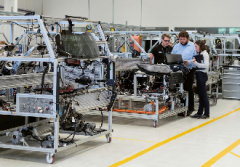Three tips to improve data collection in manufacturing

Collecting data from devices connected to the Industrial Internet of Things (IIoT) is critical in smart manufacturing. It can help, among other things, monitor the health state of machines, track stock levels and gain precious insight on how to maximise productivity. However, this can only be achieved with comprehensive and accurate data. Here Neil Bellinger, Head of EMEA at EU Automation, explains how to improve data collection.
Despite the potential of IIoT data, most of it is not currently used. For example, the McKinsey Global Institute reported that only one percent of data from an oil rig with 30,000 sensors is actually examined. The same happens in manufacturing plants across all industry sectors, where only a small amount of collected data is suitable to be processed and analysed.
One of the issues preventing data from being exploited is its quality and accuracy. Data can be incomplete or simply incorrect, for example because it has been manually collected by different people using different methods. So, what can manufacturers do to improve data collection?
Connect
One of the main technical challenges of collecting manufacturing data is that legacy machines, still prevalent in many plants, might not have been equipped with communication capabilities.
These machines often represent a huge investment and form the backbone of the factory, so data coming from them could provide critical information to improve production processes. A standard adapter might not be enough to connect legacy equipment with the IIoT and you might need to employ a systems integrator to create a middle communication layer between new and old machines. However, the possibility of gaining precious information will be worth the investment.
Data from legacy machines can help monitor their health state and warn manufacturers of possible malfunctions, giving them time to order obsolete spare parts and ultimately avoiding or minimising unplanned down-time.
Ditch manual collection
A survey by quality control company InfinityQS queried 260 manufacturers and found that 75% of them were still collecting data manually, with 47% of them using just pencil and paper.
Manual data collection increases the risk of errors because information could be registered incorrectly or completely overlooked. The problem is worsened when several collectors are involved, each with their own method. Moreover, workers might have to walk across the entire factory to collect data from several machines, which is time-consuming and inefficient.
Automating data collection is the key to success. This can be done gradually, implementing software that collects data only from the most critical equipment. Even smaller manufacturers can benefit from this - the increased accuracy of data and the man-hours saved by automating data collection will quickly amortise the investment.
Centralise and increase visibility
Manufacturers who decide to keep collecting data manually should at least have a system in place to centralise that data and make it visible to the relevant people.
Analytics applications such as SensrTrx, for example, can collect data directly from the machines and contextualise it into dashboards divided by job role and function. The cost of kind of solutions is generally remunerated in weeks.
Bridge the IT/OT gap
Sometimes, people on the factory floor are aware of whether the metrics collected by the IT team are accurate or not, but have little knowledge of how to improve the production flow. On the other hand, the IT team has the technical skills to improve operations, but can struggle to understand whether data is accurate.
Bridging this gap can improve data collection. An easy and cost effective solution is to position a touch screen for data entry directly on the factory floor, so that all employees can input data quickly and easily. The market offers rugged touch screens that are perfect for the hands-on environment of the factory floor.
Improving data collection is often the first step for manufacturers to familiarise themselves with concepts like the IIoT and digitalisation
Similar articles
More from EU Automation
- Is it time to scale up? 30th June 2021
- Innovative automation projects for manufacturers 1st June 2021
- The future of HR in manufacturing 20th May 2021
- The Help to Grow scheme - what does it mean for manufacturing? 30th March 2021












Write a comment
No comments